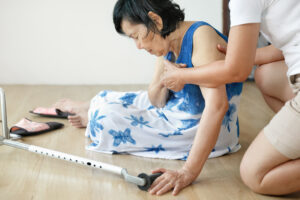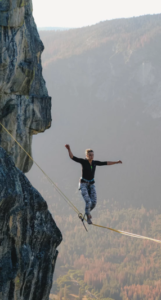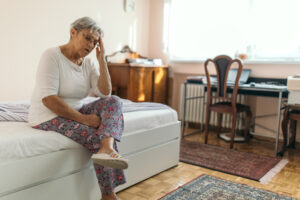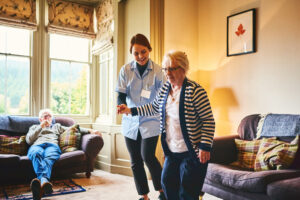Aging and balance
A little while ago my vivacious and active mother-in-law fell and severely broke her neck. She is 89. The chain of events that followed her accident has affected the entire family. At present, she requires continuous bed rest so we do our best to mitigate the loss of weight and muscle. Her lack of mobility portends an inevitable decline.
Basic fall facts

Every 11 seconds an older adult is treated in an emergency room for a fall-related injury. (Image: iStock.)
Falls are the leading cause of fatal and nonfatal injuries for older Americans and a leading threat to one’s safety and independence.
The following are the most recent U.S. Centers for Disease Control and Prevention data regarding falls among senior citizens. Let these facts sink in and then resolve to plan now to prepare yourself to be more fall-proof.
- One in four Americans aged 65+ falls each year.
- Every 11 seconds an older adult is treated in an emergency room for a fall-related injury.
- Every 19 minutes an older adult will die from a fall.
- Falls are the leading cause of fatal injury and the most common cause of nonfatal trauma-related hospital admissions among seniors. Falls result in more than 2.8 million injuries, including more than 800,000 hospitalizations and more than 27,000 deaths.
- In 2015, the total cost of fall injuries was $50 billion with Medicare and Medicaid payout of 75 percent of these costs.
- The financial toll for seniors is expected to increase as the population ages and is projected to reach $67.7 billion by 2020.
Falls, with or without injury, also carry a heavy impact on one’s quality of life. It is common for older adults to limit their activities and social engagements due to fear of falling. This can further result in physical decline, depression, social isolation, and feelings of helplessness.
Why balance is important

Balance problems may warn of other health conditions such as a heart disorder, or a problem in the brain, nervous system, inner ear, or eyes. (Image: iStock.)
Having good balance confers the ability to control and maintain one’s body position in space comfortably — whether walking, climbing stairs, standing, or even sitting still.
Without good balance, it becomes difficult to maintain an upright position and carry out simple activities of daily living, such as bathing, dressing, cooking, eating, or getting around the home.
Loss of balance raises the risk of falling and life-threatening complications. Also, balance problems may warn of other health conditions such as a heart disorder, or a problem in the brain, nervous system, inner ear, or eyes.
Balance Problems
The terms “balance problem” and “balance disorder” refer to a range of conditions with different causes but similar perceptions — the feeling that one’s balance is compromised, or that there is a diminished sense of up and down. People with a balance disorder have persistent feelings of dizziness, lightheadedness, faintness, weakness on standing, or a general sense of physical insecurity.
With good balance, muscles work smoothly in response to several sensory systems including vision, nerve signals from the inner ear, and sensations from skin nerves, muscles, limbs, and joints (called proprioception). These sensory systems supply information about the body’s position in space and the pull of gravity. Errors in any of these systems can produce a balance disorder.
Even when all these systems work perfectly, the messages they send to the central nervous system must still be processed, coordinated, and interpreted accurately by the brain. Then the brain must communicate the right instructions back out along nerves to the eyes and muscles in order to keep the body balanced. It’s complicated!
Most common balance problems
Here are the three most common balance problems.

Vertigo is a sensation that everything around a person is spinning or moving, or that the person themselves are spinning around. This is usually caused by problems in the inner ear or brain. (Image: iStock.)
Inner-ear disorders — Vertigo
Vertigo is a sensation that everything around you is spinning or moving, or that you, yourself, are spinning around. This is usually caused by problems in the inner ear or brain. The inner ear contains many tiny structures that together make up the vestibular system (the balance control center). These structures include the fluid-filled semi-circular canals lined with tiny hairs and nerves. These hairs and nerves work together to communicate a sense of head and body position and the pull of gravity. Vertigo symptoms can include severe balance problems, double vision, slurred speech, or facial weakness or numbness.
Lightheadedness or “near fainting” — Presyncope
Presyncope symptoms include feelings of weakness or dizziness that associate with sudden low blood pressure (termed orthostatic or postural hypotension). This kind of low blood pressure causes lightheadedness within three minutes of sitting up or standing. It lasts from a few seconds to several minutes. Normally, nerves and arteries work together to counteract the force of gravity and keep blood evenly distributed throughout the body, not pooled in the legs or abdomen as occurs during presyncope. Many conditions including dehydration, heart problems, age-related nerve problems, long-term bed rest, anemia, and certain blood pressure medications can interrupt this natural process and precipitate a sudden drop in blood pressure causing lightheadedness and a loss of balance.
Muscle/nerve disfunction
Aging and muscle loss usually result in weakness of postural, core, and leg muscles responsible for whole-body stabilization. Accompanying muscle/nerve disfunction are feelings of unsteadiness, disorientation, and occasionally a loss of sense of time or place. With weak postural and core muscles, normal balance becomes compromised resulting in falls, particularly during movement-termed dynamic balance.
Causes
Even healthy older adults can experience diminished balance compared to when they were younger. Here is a list of possible conditions that can initiate balance problems.
- Inner ear problems (the most common source of vertigo)
- Headaches, including migraines
- Anxiety or panic
- Ringing in the ears
- Allergies or infections
- Getting up quickly from sitting or lying down
- A growth on the auditory nerve that works with the ear (such as an acoustic neuroma)
- Dehydration
- Eye problems such as cataracts, glaucoma, diabetic retinopathy, or macular degeneration
- Arthritis
- Numbness in feet and legs (peripheral neuropathy)
- Long-term diseases of the nervous system (Multiple Sclerosis, Parkinson’s disease, Alzheimer’s disease)
- Joint or muscle problems
- Different medications including anti-epileptic drugs, sedatives, tranquilizers, beta-blockers, blood pressure medications, some antidepressants, and nitroglycerin (heart medicine) if taken with erectile dysfunction medication
- Opioids
- Sleep medications
- Natural medications such as Ginkgo Biloba, Melatonin, St. John’s Wort, and Cannabis
Combining drugs or drinking alcohol with any medication may intensify unsteadiness and cause unwanted falls.
Diagnoses
Balance problems generally occur after a person falls and is injured. A typical balance assessment begins with gathering subjective patient data that includes a detailed medical history, review of medications, and any other factors that could contribute to loss of balance. A brief history of recent falls is particularly important.
Musculoskeletal function, functional mobility and gait, movement strategies, and sensory systems involved with balance are also evaluated. Finding the source of balance problems can involve different medical specialties including an otolaryngologist (i.e., ENT, ear/nose/throat specialist) if inner ear problems are suspect, a cardiologist if irregular heartbeats are present, a neurologist if there is concern about damaged nerves, and a physical therapist or exercise physiologist if there are concerns regarding muscle/nerve imbalances or weaknesses.
Musculoskeletal function
Musculoskeletal assessment involves a comprehensive examination of strength, range of joint motion, posture, pain, and presence of abnormal muscle tone.
Another aspect of musculoskeletal function that impacts balance is loss of flexibility in the spine — particularly spinal extension (bending backward). Most often, poor postural alignment leads to balance insecurity. Also, ankle flexibility is critical for postural control.
Sensory system function
The somatosensory system — part of the sensory system concerned with the conscious perception of touch, pressure, pain, temperature, position, movement, and vibration that arise from muscles, joints, skin, and fascia – has a strong influence on balance. Sensory receptors for touch, temperature, pressure, joint and muscle stretch, vibration, and pain continuously feed sensory information to the brain where it is processed and routed back out to the muscles to make quick and automatic adjustments that promote good balance to avoid falling.
Balance and postural control are affected by changes in vision. Visual changes that occur with aging — loss of visual acuity, narrowing of visual fields, decreased light-dark adaptation, increased sensitivity to glare, and loss of peripheral vision and depth perception – aid in maintaining proper balance.
The vestibular system provides the brain with information about motion, head position, and spatial orientation as well as motor functions to stabilize the head and body during movement. It helps maintain body orientation, sense of direction, and speed of movement. These qualities help maintain balance.
Balance assessment

A typical balance assessment begins with gathering subjective patient data that includes a detailed medical history, review of medications and any other factors that could contribute to loss of balance. A brief history of recent falls is particularly important. (iStock.)
Assessing functional balance and postural control involves tests and measures to determine a person’s abilities in both the clinical and home environment. Many different tests are available that predict risks of falling. One easy functional balance test is the “Get Up And Go Test.” This test measures how long it takes a person to rise from a chair, walk 10 feet to a line on the floor, and return to the chair. In a study of older adults with balance problems, people taking 30 seconds or more to complete this task were more likely to need an assistive device, walk too slowly for community ambulation, and score lower on other balance tests. In contrast, a person completing the test in less than 20 seconds was more likely to be independent in daily living activities and walk at a speed sufficient for community mobility. Results of this test have been shown to predict balance issues and fall risk with good precision. View samples of this test.
Another common balance test is the 16-item “Berg Functional Balance Scale” that includes static and dynamic tasks scored on a 0-4 scale. For each task, a score of 0 indicates an inability to perform the task while a score of 4 means successfully completing the task. Each task can be performed with minimal equipment and in a small space, even at home. Normally these assessment tests are performed under the supervision of a health-care provider. Here are the tasks and a link explaining how to perform and score each task:
- Sitting to standing without using hands for support
- Standing unsupported for two minutes without holding on
- Sitting unsupported without holding on
- Sitting unsupported, feet on the floor, with arms folded for two minutes
- Standing to sitting without holding on
- Transferring from a chair or bed and back again
- Standing unsupported with eyes closed for 10 seconds
- Standing unsupported with feet together without holding on
- Reaching forward with outstretched arms
- Picking up an object from the floor in front of you
- Turning to look behind, over left and right shoulders
- Turning 360 degrees around in a full circle; repeat other direction
- Count number of times stepping up and down on a small stool or stair
- Standing unsupported, one foot in front of the other
- Standing on one leg without holding on
Six exercises to improve balance

Research shows that seniors can decrease the risk of falling by regularly practicing simple balance exercises. Paired with strength exercises, these simple movements can improve the body’s ability to control and maintain body position in space. (Image: iStock.)
Research shows that seniors can decrease the risk of falling by regularly practicing simple balance exercises. Paired with strength exercises, these simple movements can improve the body’s ability to control and maintain body position in space.
Here are six simple exercises you can do anytime, anywhere that are aimed at improving balance and lower body strength. Remember, always check with a health-care professional to ensure readiness to perform these tasks. Click on the name of the exercise to see a visual guide.
Single leg stand
Stand behind a steady, solid chair. If needed, hold on to the top. Lift up the right foot and balance on the left foot without holding on. Maintain the position for as long as possible, then switch to the other foot. The goal is to stand on one foot without holding on for one minute.
Heel-to-toe walk
Put yourright foot in front of your left foot so that the heel of the right foot touches the toes of left foot. Move the left foot in front of the right and repeat the step with the left foot. Walk this way for 20 steps without holding on to anything.
Foot tapping
Stand tall with feet hip-width apart in front of a step (i.e., the bottom step of a staircase). If needed, hold on to the wall or a sturdy piece of furniture. Slowly raise one foot to tap the step in front, and then slowly return your foot to the floor. Perform 15 to 20 taps, then repeat on the opposite leg.
Head bends/turns
Stand tall with feet hip-width apart and your hands on your hips. (If needed, hold on to the wall or a sturdy piece of furniture.) Slowly move the head from side to side, then up and down while keeping your body as still as possible. Do each movement for 20 seconds. If dizzy, pause and move your head more slowly — or stop.
Standing marching
Stand tall with feet hip-width apart. If needed, hold on to the wall or a sturdy piece of furniture. Lift one knee until your thigh is parallel to the floor, or as close to parallel as possible, while keeping the torso straight. Avoid leaning. Pause, then slowly return your foot to the floor. Perform 20 marches, alternating between legs with each march.
Stand-to-sit; sit-to-stand
Stand tall with a sturdy chair behind; feet hip-width apart. If needed, hold on to the wall or a sturdy piece of furniture. Sit down by slowly lowering your hips onto the chair as gently as possible. Pause, and without swinging your torso, stand up. Perform 10 repetitions of stand-sit; sit stand.
References
- Berg, K., et al. 1992. “Measuring balance in the elderly: Validation of an instrument.” Canadian Journal of Public Health; 83(S2): S7.
- Burton, E., et al. 2019. “Physical activity programs for older people in the community receiving home care services: Systematic review and meta-analysis.” Clinical Interventions in Aging; 14:1045-1064.
- Jin, J. 2018. “Prevention of falls in older adults.” Journal of the American Medical Association; 319(16):1734.
- Liu-Ambrose, T., et al. 2019. “Effect of a home-based exercise program on subsequent falls among community-dwelling high-risk older adults after a fall a randomized clinical trial.” Journal of the American Medical Association; 321(21):2092.
- Sarmiento. K., Lee, R. 2017. “STEADI: CDC’s approach to make older adult fall prevention part of every primary care practice.” Journal of Safety Research; 63:105.
- Shumway-Cook. A., Woollacott, M. 2007. “Motor control: Translating research into clinical practice.” 3rd ed. Lippincott Williams & Wilkins; Philadelphia.
- Silsupadol, P., et al. 2009. “Effects of single-task versus dual-task training on balance performance in older adults: A double-blind, randomized controlled trial.” Archives of Physical Medicine and Rehabilitation; 90(3):381.
- Taylor, D., et al. 2019. “An interprofessional education approach to fall prevention: Preparing members of the interprofessional healthcare team to implement STEADI into practice.” Gerontology & Geriatrics Education; 40(1):105.
- Thomas, E., et al. 2019. “Physical activity programs for balance and fall prevention in elderly: A systematic review.” Medicine (Baltimore); 98(27):e16218.
- Vincenzo, J., Patton, S.K. 2019. “Older adults’ experience with fall prevention recommendations derived from the STEADI.” Health Promotion Practice, Jul 27:1524839919861967. doi: 10.1177/1524839919861967.



primary health care San Antonio
These are helpful facts and tips especially for older people prone to falls. Thank you for the share!
primary health care San Antonio
Reply